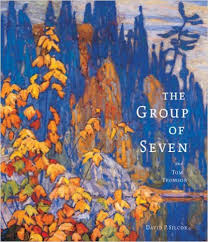 SOUNDTRACK: RHEOSTATICS-Music Inspired by the Group of 7 (1995).
SOUNDTRACK: RHEOSTATICS-Music Inspired by the Group of 7 (1995).
 In music there’s always a… key in which the composition is set… In painting there’s a mother color that goes through all–it holds the painting together…you might call it the signature of the painting.
In music there’s always a… key in which the composition is set… In painting there’s a mother color that goes through all–it holds the painting together…you might call it the signature of the painting.
And thus opens the Rheostatics Group of 7 record. I had always been vaguely dismissive of the album because it is mostly instrumental and, while good, I just didn’t listen to it that much. After seeing it live it’s time for a reappraisal.
The disc opens with “One” a lovely minute-long piano introduction. It’s followed by “Two” which has a series of piano and guitar trills as they set a bucolic mood. Then the drums kick in. This song starts slowly with some plucked strings (and a sample from Queen Elizabeth). What I love about this piece is that after the trills, the song seems to build to a very cool cello riff (provided by drummer Don Kerr). Then there’s a vocal section (of bah bahs) which was really highlighted when they played it live.
The first highlight of this record for me is “Three,” which is known as the Boxcar song. Someone shouts “All aboard” as the chugging begins and the cello and drums keep an excellent rhythm with Martin’s amazing guitar melody. “Five” is another waltz with, to my ears, a vaguely Parisian sound. Martin sings a few verses (and a chorus of “blue hysteria”). It’s a lovely, delicate piece.
“Six” is a longer piece which centers around a slowly swirling guitar and cellos motif. It ends with some noisy moments and more rainfall. Until a noir sounding coda creeps up with piano and upright bass,.
Then comes “Seven” a cello based version of the awesome song “Northern Wish.” I prefer the original because it is so much more intense, but this quieter version is really interesting and subtle. “Nine” starts slowly with some gentle acoustic guitars. But it builds and grows more intense (it has the subtitle “Biplanes and bombs”). As the song progresses (around 3 minutes) Tielli’s guitar comes in and the backing notes grow a little darker. The last 15 second are sheer noise and chaos (live they stretched this section out for a while, and it was very cool to see Hugh Marsh makes a lot of noise with his violin).
“Ten” uses some nontraditional instruments including what I assume is a didgeridoo and all kinds of samples. On stage Tim and Kevin were swinging those tubes that whistle to make the noises).
Eleven is a reprise of track one, Kevin’s Waltz, with the vocals sung by Kevin Hearn.
I have really come to appreciate this album a lot more. It doesn’t have any of my favorite songs on it, but it is a really amusing collection fo songs.
[READ: August 20, 2015] The Group of Seven and Tom Thompson
I have had this book for a number of years. I’m not even sure where I got it (in hardback no less). I know that I purchased it because of the Rheostatics, because I had never heard of the Group of Seven before the band made their record inspired by them. Since I was going to see the paintings live, I decided to read up about the Group a bit more (I liked the paintings a lot, I just hadn’t read much).
Sadly, the Art Gallery of Ontario wasn’t open for viewing when we went to the concert (which makes sense as it was at night) and we didn’t have another opportunity to go to AGO. Fortunately, we also went to Casa Loma which had a room full of Go7 paintings, so I was delighted to see some of these up close. (They may have been prints, it was unclear, but it was cool seeing them).
So the Group of Seven were (initially) seven Canadian painters who joined together to create uniquely Canadian works of art from 1920 to 1933. Their art was meant to celebrate their country which they felt was under-represented in art. They planned to not follow conventional European styles of painting and often made striking scenes of nature. They are largely known for their landscapes, although they also painted portraits and other works.
The Group of 7 originally originally consisted of (links are to Wikipedia bios): Franklin Carmichael (1890–1945), Lawren Harris (1885–1970), A. Y. Jackson (1882–1974), Frank Johnston (1888–1949), Arthur Lismer (1885–1969), J. E. H. MacDonald (1873–1932), and Frederick Varley (1881–1969). Later, A. J. Casson (1898–1992) was invited to join in 1926; Edwin Holgate (1892–1977) became a member in 1930; and LeMoine FitzGerald (1890–1956) joined in 1932.
Two artists commonly associated with the group are Tom Thomson (1877–1917) and Emily Carr (1871–1945). (more…)
